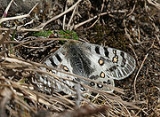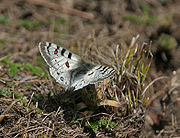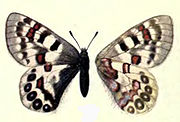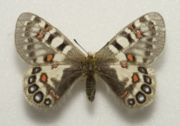
Parnassius hardwickii
Encyclopedia
Common Blue Apollo Parnassius hardwickii is a high altitude butterfly which is found in South Asia
. It is a member of the Snow Apollo genus Parnassius
of the Swallowtail (Papilionidae) family. This butterfly is found from Chitral
to Sikkim
and is found from 6000 ft to 17,000 ft, making it one of the most commonly encountered species of Apollo in India
.

_i_img_7201.jpg)
Male upperside creamy-white. Fore wing : base and costal margin densely irrorated with black scales ; a broad short velvety black bar across middle of cell, another along the discocellulars and a third beyond apex of cell, this last with superposed spots of crimson where the bar crosses the bases of interspaces 5 and 8 ; a crimson-centred black spot in middle of interspace 1; an irregularly curved prominent postdiscal series of dusky-black spots, so arranged as to leave a narrow edging of the creamy-white ground-colour beyond, which is traversed by the black veins; the upper four spots of the postdiscal series fused to form a broad, continuous, but short, curved band; the terminal margin broadly dusky black ; the cilia white. Both the dusky-black band and the postdiscal dusky-black markings sub-hyaline. Hind wing: base and dorsal margin broadly dusky black, the inner margin of the black coloration on the latter deeply but irregularly bi-emarginate; a crimson-centred black spot near base of interspace 5, another just beyond the middle of interspace 7, followed by a very conspicuous curved postdiscal series of five dull blue ocelli ringed with black and centred with white, and a narrow diffuse dusky black terminal band; cilia as in the fore wing. Underside: similar, with a glassy appearance. Fore wing: with the markings of the upperside visible by transparency; the white scaling of the upperside replaced by scale-like hairs of the same colour; the only scaled markings are the medial and apical transverse black bars in cell, three small crimson spots beyond and the black-encircled crimson spot in middle of interspace 1. Hind wing: the white scaling along the basal half of the costal margin nearly as on the upperside, the rest hair-like as on the underside of the fore wing; a broad basal band of four crimson or vermilion-red spots followed by a discal irregular series of five similarly-coloured spots, the lower three formed into a short obliquely transverse band above the tornal angle; all the crimson spots encircled more or less obsoletely by black rings, and the following prominently centred with white: the spot in interspaces 2 and 5 and the basal and medial spots in interspace 7.
 Female similar; the dusky black irroration on the upperside of the fore wing more extensive and formed into a narrow irregular band below the cell, which runs between the crimson spots beyond the cell-apex and the crimson spot in interspace 1; the crimson spots are larger, with an additional spot in interspace 6 of the fore wing and a pretornal spot on the hind wing. Underside: similar to that of the male but all the red spots much larger and with white scaling in the centre. Antennae nearly black, with only a few white specks, head with brownish-yellow pubescence; rest of the thorax and abdomen covered densely with long white hairs which also clothe, more or less narrowly, the dorsal margin of the hind wing.
Female similar; the dusky black irroration on the upperside of the fore wing more extensive and formed into a narrow irregular band below the cell, which runs between the crimson spots beyond the cell-apex and the crimson spot in interspace 1; the crimson spots are larger, with an additional spot in interspace 6 of the fore wing and a pretornal spot on the hind wing. Underside: similar to that of the male but all the red spots much larger and with white scaling in the centre. Antennae nearly black, with only a few white specks, head with brownish-yellow pubescence; rest of the thorax and abdomen covered densely with long white hairs which also clothe, more or less narrowly, the dorsal margin of the hind wing.

South Asia
South Asia, also known as Southern Asia, is the southern region of the Asian continent, which comprises the sub-Himalayan countries and, for some authorities , also includes the adjoining countries to the west and the east...
. It is a member of the Snow Apollo genus Parnassius
Parnassius
Parnassius is a genus of northern circumpolar and montane butterflies usually known as Apollos. They can vary in colour and form significantly based on their altitude. They also show an adaptation to high altitudes called altitudinal melanism...
of the Swallowtail (Papilionidae) family. This butterfly is found from Chitral
Chitral
Chitral or Chetrar , translated as field in the native language Khowar, is the capital of the Chitral District, situated on the western bank of the Kunar River , in Pakistan. The town is at the foot of Tirich Mir, the highest peak of the Hindu Kush, high...
to Sikkim
Sikkim
Sikkim is a landlocked Indian state nestled in the Himalayan mountains...
and is found from 6000 ft to 17,000 ft, making it one of the most commonly encountered species of Apollo in India
India
India , officially the Republic of India , is a country in South Asia. It is the seventh-largest country by geographical area, the second-most populous country with over 1.2 billion people, and the most populous democracy in the world...
.
Description

_i_img_7201.jpg)
- See glossaryGlossary of Lepidopteran termsThis glossary describes the terms used in the formal descriptions of insect species, jargon used mostly by professionals or entomologist....
for terms used
Male upperside creamy-white. Fore wing : base and costal margin densely irrorated with black scales ; a broad short velvety black bar across middle of cell, another along the discocellulars and a third beyond apex of cell, this last with superposed spots of crimson where the bar crosses the bases of interspaces 5 and 8 ; a crimson-centred black spot in middle of interspace 1; an irregularly curved prominent postdiscal series of dusky-black spots, so arranged as to leave a narrow edging of the creamy-white ground-colour beyond, which is traversed by the black veins; the upper four spots of the postdiscal series fused to form a broad, continuous, but short, curved band; the terminal margin broadly dusky black ; the cilia white. Both the dusky-black band and the postdiscal dusky-black markings sub-hyaline. Hind wing: base and dorsal margin broadly dusky black, the inner margin of the black coloration on the latter deeply but irregularly bi-emarginate; a crimson-centred black spot near base of interspace 5, another just beyond the middle of interspace 7, followed by a very conspicuous curved postdiscal series of five dull blue ocelli ringed with black and centred with white, and a narrow diffuse dusky black terminal band; cilia as in the fore wing. Underside: similar, with a glassy appearance. Fore wing: with the markings of the upperside visible by transparency; the white scaling of the upperside replaced by scale-like hairs of the same colour; the only scaled markings are the medial and apical transverse black bars in cell, three small crimson spots beyond and the black-encircled crimson spot in middle of interspace 1. Hind wing: the white scaling along the basal half of the costal margin nearly as on the upperside, the rest hair-like as on the underside of the fore wing; a broad basal band of four crimson or vermilion-red spots followed by a discal irregular series of five similarly-coloured spots, the lower three formed into a short obliquely transverse band above the tornal angle; all the crimson spots encircled more or less obsoletely by black rings, and the following prominently centred with white: the spot in interspaces 2 and 5 and the basal and medial spots in interspace 7.


Range
Himalayas, Northern India (including Jammu & Kashmir and Sikkim), Pakistan, Nepal, Tibet and China.Other references
- Sakai S., Inaoka S., Toshiaki A., Yamaguchi S., Watanabe Y., (2002) The Parnassiology. The Parnassius Butterflies, A Study in Evolution, Kodansha, Japan. ISBN 4-06-124051-X
- Weiss J.-C., (1999) Parnassiinae of the World - Part 3, Hillside Books, CanterburyHillside Books, Canterbury- Origin :It was established in 1989 and was directed by Lydie Leforestier.The name comes from they were initially located Hillside Avenue at Canterbury.Then, they were situated in Lindfield, West Sussex, U.K.- Activities :...
, UK. ISBN 0-9532240-2-3

